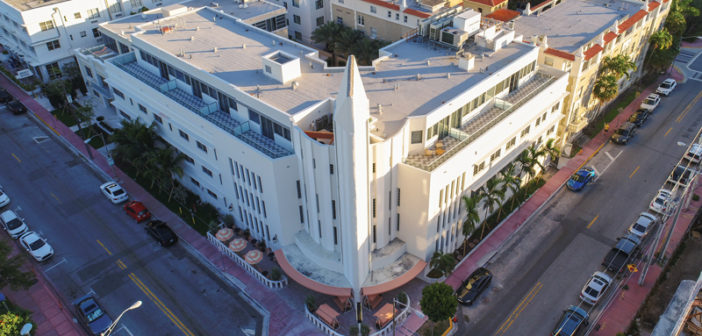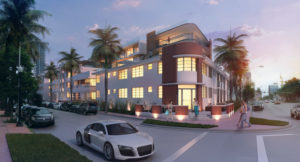MIAMI BEACH, FL—The Bass Museum District here is undergoing a makeover, a revitalization of sorts, and Kobi Karp, founder of Kobi Karp Architecture & Interior Design Inc. (KKAID), is on board with efforts to transform this area into a walkable, bustling neighborhood and popular vacation destination.
“KKAID takes on unique projects that have opportunities to create cultural, environmental, architectural, community and urban statements, while seeking out projects which it finds to be complicated and individualistic,” said Karp, who founded his firm in 1996.
An area of primary focus for KKAID currently is the Bass Museum District. This particular section of the city is home to numerous art galleries and creative organizations, including the Bass Museum of Art, which reopened in October, and the Miami City Ballet—just to name a couple.
“The Bass Museum District is a crucial historic district in Miami Beach with ties to a past in entertainment during the ’20s, ’30s and ’40s,” he explained. “Today, the oceanfront property includes a block of open green space parallel to the ocean that opens to the Bass Museum and is adjacent to significant hotels such as The Setai and the W Hotel. The district was created to include dance, art and culture with the surrounding hotels. Because of its location, it is an important area in Miami Beach. From a pedestrian standpoint, it connects and relates the oceanfront to the park at the Bass Museum through the convention center to the west.”
At the district’s core, the Bass Museum has become the community’s anchor. The museum has “influenced me to design a district and neighborhood for people to live, work and be entertained within,” Karp said. The institution has been expanded over the years to accommodate new works of art.
The architecture and interior design firm is revamping several hotels in this Miami neighborhood, including The Plymouth; the Lennox (previously known as the Peter Miller Hotel); Ansonia; Sadigo Court, which was just recently approved; Jade 18; and Collins Park Hotel, which is currently undergoing construction.
The art deco influence on Miami Beach can be seen throughout the city. KKAID builds upon this framework for projects within the neighborhood.
“[The art deco influence] inspires us to move forward with the renovation, restoration and preservation of the buildings, as well as adding on new contemporary and modern structures, which relate to the historic DNA,” Karp said. “This allows us to create modern spaces for dining, lounging and hospitality, critical for maintaining a financially successful and operational hotel individualistic to the project itself. The ocean is what defines Miami Beach, but the art deco elements are what give it personality, and the fusion of the two has been the backbone of the beauty, popularity and success of the area throughout time.”
Other completed projects by KKAID in Miami Beach include properties in the Hyatt Centric, AC Hotels by Marriott, Residence Inn by Marriott, 1 Hotels and Kimpton Hotels & Restaurants brands. Additionally, Hotel Astor recently received the AIA Miami “Test of Time” Merit Award of Excellence for its renovation.
The firm’s design approach involves interpreting the historic character of the existing property first. KKAID then leverages the combination to construct its framework for “creating hip, cool, cutting-edge, contemporary spaces and allowing us to utilize the building in a more consistent, intelligent way,” said Karp.
Take The Plymouth, for example. “We took a structure that was originally used for multifamily residential and converted it into a hotel that encompasses a high-end food and beverage element that fully utilizes the original oval-shaped body,” he said. “The wall-painted mural with the horizontal ceiling system opens to the new restaurant, which enables people to sit on multi-levels and enjoy the dining experience upon entering the historic lobby.”
As for future projects, Karp said, “We are open to whatever new and exciting projects come our way.” While this may be true, this neighborhood stands out.
“KKAID was picked by developers who were looking for unique solutions for their projects,” he said. “They relied on our experience in renovation and restoration. Our ability to extend the vision and expand structures with new additions, which complement the historic buildings, creates unlimited possibilities for new uses and advantages. The end result is an aesthetically beautiful fusion of old and new with a culturally intrinsic story, which is critical for the success of hospitality and food and beverage services.”
Known primarily for hospitality projects and historic preservation work, KKAID has done work globally, from tropical resorts in the Caribbean and ski resorts in Colorado to projects in Abu Dhabi, Israel and Saudi Arabia. The firm has also completed projects in other historic districts around the world, including the Miraflores district in Lima, Peru.
“Each project we take on is individually evaluated to preserve the character of its location and history, enabling us to create hospitality projects that are distinct works of art, and that is why our designs repeatedly won awards and receive recognitions,” Karp said.
For KKAID, there’s a bigger picture when it’s designing a building. “This gives us a standout sensibility and perspective that truly sets us apart and keeps us top of mind in the hospitality market,” he said. The focus isn’t only on the building itself; the firm also takes into consideration the historic elements, the surroundings and environment, the unique aspects of the neighborhood and the type of people that will enjoy the new project.
While KKAID may be moving in fast into the neighborhood, there’s still more to be done, and that’s what its top executive plans to do in 2018. “Miami Beach still has a lot of hidden gems waiting to be discovered and brought back into the spotlight,” he said. “We expect to play an integral role in that.” HB



